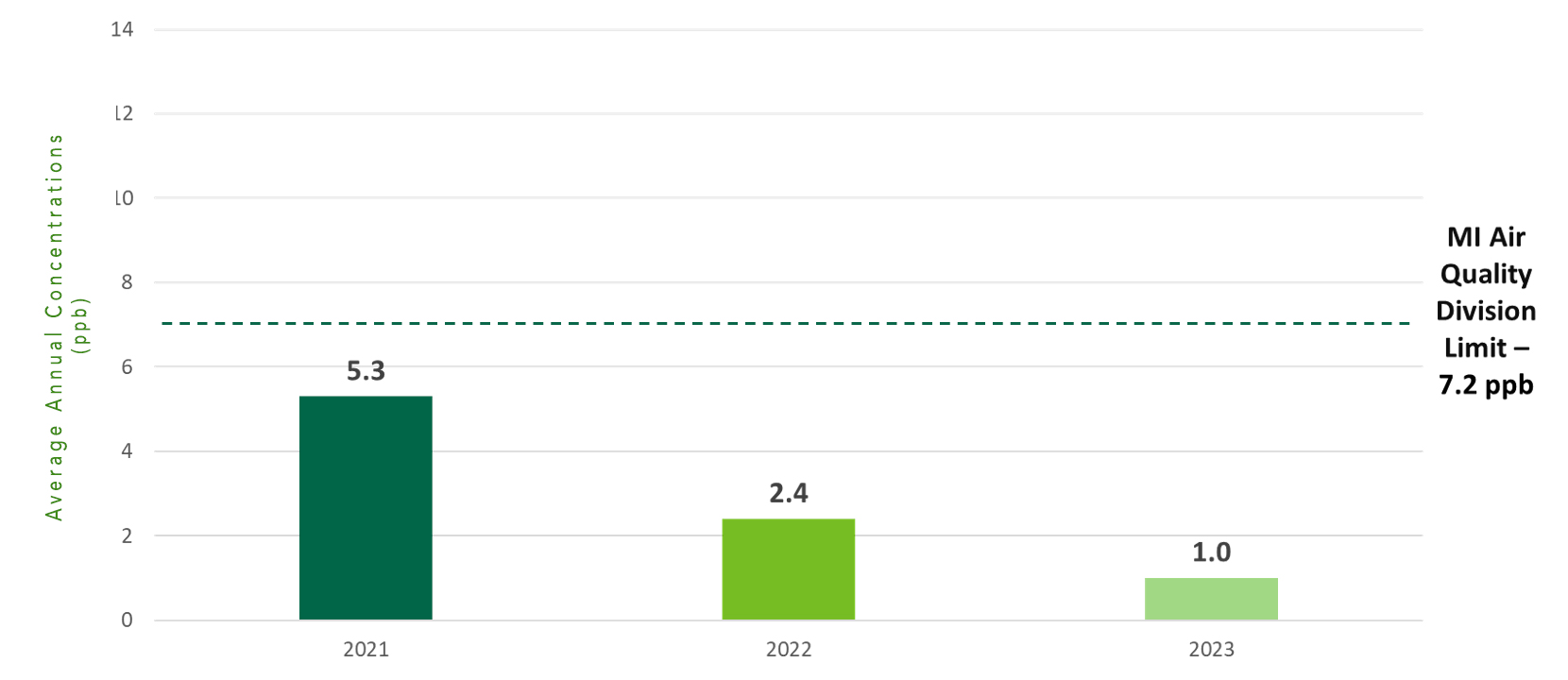What is hydrogen sulfide (H2S)?
Although H2S can smell bad, the U.S. Environmental Protection Agency (EPA) does not consider it a hazardous air pollutant.
- Hydrogen sulfide is a colorless gas that occurs naturally and comes from a variety of sources – from hot springs, natural gas and crude petroleum to industrial activities and wastewater treatment plants.
- H2S is produced when bacteria break down plant and animal material.
- Environmental factors, such as shifts in the wind and wildfires, can make concentrations of H2S appear to be higher than they are.
Graphic Packaging’s average onsite H2S emissions in 2023 are 1.0 parts per billion (ppb)
This is more than 6 times below the state’s regulatory standard and below the EPA’s reference level for continuous lifetime exposure
It is also important to know that brief increases in H2S readings are not considered harmful and often result simply from a shift in the wind or an inaccurate air monitor reading, especially when similarly higher numbers are not seen from the surrounding monitors. The important numbers – which the state regulates – are the average emissions over a day or a year. Our mill is well under those limits.
Graphic Packaging’s Emissions are Well Within Regulatory Limits
7.2 parts per billion (ppb)
Limit of H2S Michigan allows as an annual average at the property line.
1.4 parts per billion (ppb)
EPA’s reference level for continuous lifetime exposure to H2S.
Since 2021, we’ve cut H2S concentrations by 81% from levels that were already under state limits.

(2023 YTD through June 30)
The annual averages were calculated using all the available data from the on-site Envirosuite H2S Monitors utilizing 15-minute readings – there were no adjustments for false positives during power outages or similar conditions.
Significant Actions to Improve Air Quality and Reduce Odor
Graphic Packaging is committed to improving air quality and reducing odors in the community where we live and work. The health and safety of our employees and neighbors are our top priorities. That is why we have taken – and are continuing to take – significant steps to ensure that we are part of the solution to air quality and odor issues.
We will have invested more than $8 million in health and safety improvements at the mill by the end of 2023, based on guidance from independent, third-party experts who specialize in paper mill operations and odors. These steps include:
Implementing state-of-the-art H2S and odor mitigation techniques including optimizing chemical processes in our wastewater
Initiating a plan to install both a permanent oxygenation system and scrubbing system to further reduce H2S emissions
Actively participating in the City of Kalamazoo’s Odor Task Force since 2019 and supporting the City’s creation of an Odor Hotline
Developing and implementing our own Odor Action Plan
Installing 16 EnviroSuite monitors around our mill and providing the public with live online access to the emissions they measure
Constantly evaluating emerging technologies for further odor reduction
Even still, this is a complex issue that requires time, teamwork and effort to control other sources of H2S on the Northside. That is why we have been partnering closely with state agencies, the city’s sewage treatment plant next door, the city and other experts to tackle it from every angle – and we won’t stop until it’s resolved.
Michigan Department of Health and Human Services Study
In a health assessment released in May 2023, the Michigan Department of Health and Human Services (MDHHS) looked at H2S levels surrounding our mill and our neighbor, the Kalamazoo Water Reclamation Plant.
- MDHHS found no short-term or mid-term health impacts or correlation with asthma or other life-threatening illnesses resulting from emissions. These findings accounted for vulnerable groups, such as children and older adults.
- This study is consistent with findings from data presented in October 2021 by the Michigan Department of Environment, Great Lakes, and Energy (EGLE), the U.S. EPA, and MDHHS that also concluded that there are no short-term health concerns from H2S at the Graphic Packaging mill.
Media & Public Statements
- Graphic Packaging Invites Channel 3 on Mill Tour
- Graphic Packaging’s Statement on MDHHS Study & Odor Action Plan
- Media Advisory: Pitcher Street Road Closure – September 2021
- GPHC Announces Kalamazoo, Michigan Mill for New Coated Recycled Board Machine Investment
For more information:
